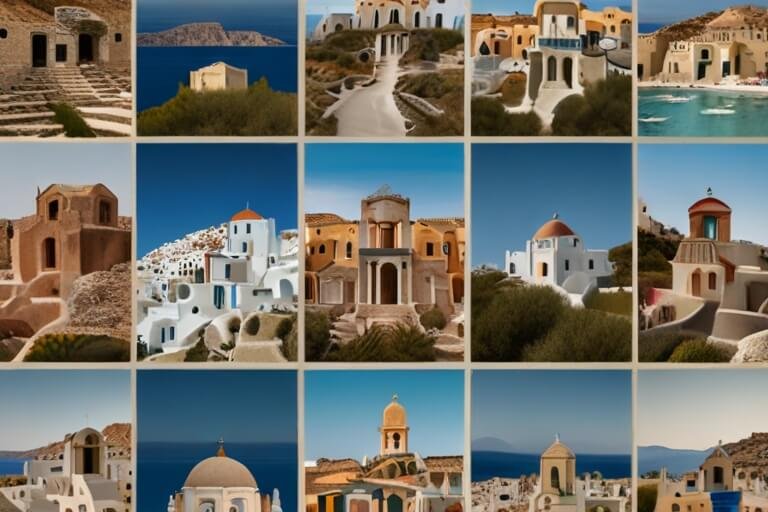How Many Days in Greece Is Enough? Unlocking 10-Day Mesmerizing Adventures
The Allure of Greece
Greece, with its rich tapestry of history, breathtaking landscapes, and sun-drenched islands, casts an irresistible spell on wanderers. Imagine standing atop the Acropolis, where ancient gods once roamed, or sipping wine as the sun dips into the Aegean Sea. Picture yourself winding through narrow alleys in Santorini, where whitewashed buildings cling to cliffs like pearls on a necklace. And don’t forget the lesser-known islands—the hidden gems that whisper secrets only to those who seek them.
But here’s the delightful dilemma: How many days in Greece are enough? Is it a whirlwind affair or a leisurely exploration? Fear not; we’re here to guide you through this enchanting maze.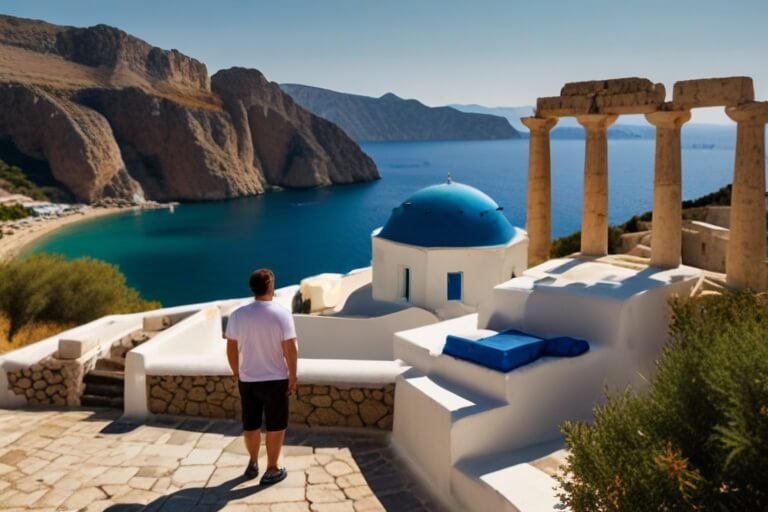
1. The Ideal Duration: Balancing Exploration and Tranquility
The ideal number of days to spend in Greece depends on your travel preferences, interests, and the specific destinations you wish to visit. Here are some guidelines:
Quick Getaway (4-7 Days)
If you’re planning a short escape, focus on Athens and one or two Greek islands. Here’s a snapshot of what you can explore:
- Athens: Spend time exploring the Acropolis, the ancient Agora, and the vibrant Plaka neighborhood. Don’t miss the changing of the guard at Syntagma Square.
- Santorini: Known for its dramatic caldera views and white-washed buildings, Santorini is a romantic paradise. Watch the sunset in Oia and savor local delicacies by the sea.
- Mykonos: Party lovers, rejoice! Mykonos offers lively beach clubs, narrow alleys, and a pulsating nightlife. Explore the iconic windmills and dance till dawn.
Classic Journey (10-14 Days)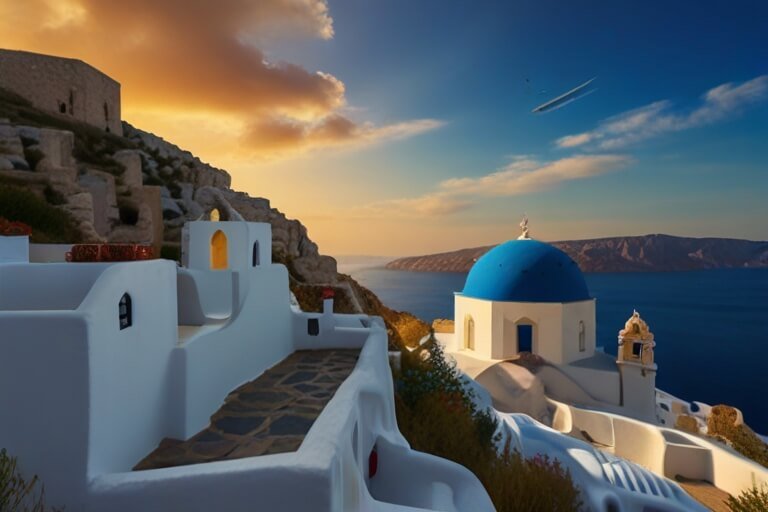
For a more immersive experience, extend your stay to 10-14 days. Add these gems to your itinerary:
- Delphi: Venture to the mystical site of Delphi, once considered the center of the world. Explore the Temple of Apollo and soak in the ancient energy.
- Crete: Greece’s largest island, Crete, boasts Minoan ruins, rugged gorges, and pristine beaches. Visit Knossos Palace and hike the Samaria Gorge.
- Nafplio: Wander through Nafplio’s cobblestone streets, visit the Palamidi Fortress, and indulge in seafood by the harbor. It’s a charming escape.
Extended Odyssey (15+ Days)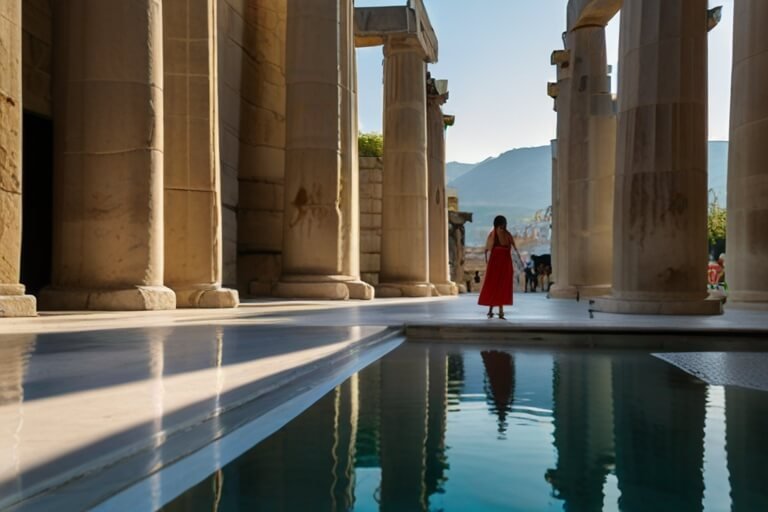
For a truly enchanting odyssey, allocate 15 or more days. Consider these additions:
- Meteora: Marvel at the monasteries perched atop towering rock formations. Meteora is a spiritual haven that defies gravity.
- Rhodes: Explore the medieval Old Town, visit the Palace of the Grand Master, and unwind on pristine beaches. Rhodes combines history with relaxation.
- Corfu: Verdant landscapes, Venetian architecture, and azure waters await in Corfu. Discover hidden coves and sample local olive oil.
Practical Tips
- Local Cuisine: Savor moussaka, souvlaki, and baklava.
- Island Hopping: Ferries connect the islands seamlessly.
- Sun Protection: Pack sunscreen and a wide-brimmed hat.
Key Takeaways: How many days in Greece is enough?
| Duration | Highlights |
|---|---|
| 4-7 Days | – Explore Athens: Acropolis, Plaka, and Syntagma Square.<br>- Island hop to Santorini or Mykonos. |
| 10-14 Days | – Add Delphi and Crete to your itinerary.<br>- Discover Nafplio’s charm. |
| 15+ Days | – Extend to Meteora and Rhodes.<br>- Unwind in Corfu’s lush landscapes. |
How Many Days in Greece Is Enough? Your Ultimate Guide
The Siren Call of Greece
Greece—a symphony of azure seas, ancient ruins, and sun-drenched islands—beckons travelers with promises of adventure and wonder. As you step onto this mythical stage, the question echoes: How many days in Greece are enough? Fear not, fellow wanderer; we’ve crafted a comprehensive guide to help you find the perfect duration for your Greek odyssey. From Athens to Santorini, let’s embark on an extraordinary voyage.
Certainly! Let’s delve into more details about choosing the right season for your Greek adventure:
1. Choose Your Season Wisely
Summer (June to August)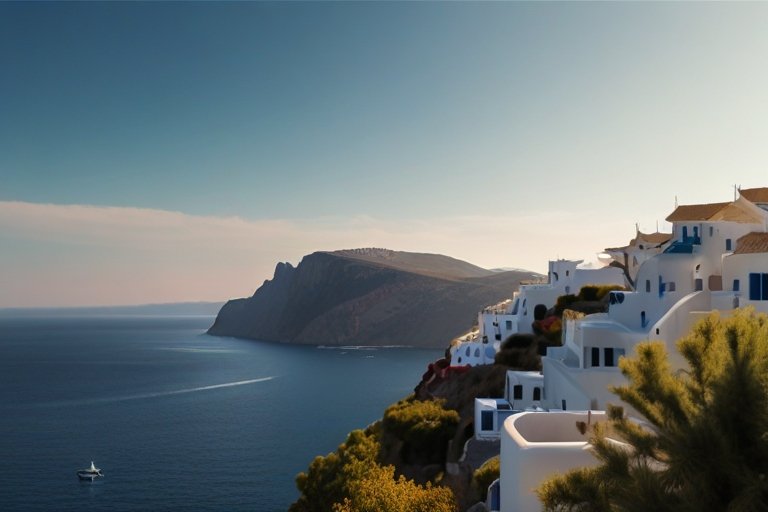
- Ideal for Beach Lovers: If you dream of sun-kissed shores, crystal-clear waters, and lazy days on the beach, summer is your season. Greece’s beaches come alive during these months. From the famous Elafonissi Beach in Crete to the lesser-known Navagio Beach in Zakynthos, you’ll find a paradise for every beach enthusiast.
- Water Activities: Dive into the Aegean Sea for snorkeling, scuba diving, and sailing. The warm waters are perfect for exploring underwater caves and shipwrecks.
- Crowded Attractions: Be prepared for bustling crowds at popular tourist spots. The Acropolis in Athens, Santorini’s caldera viewpoints, and Mykonos’ windmills will be teeming with fellow travelers.
- Higher Prices: Accommodations, flights, and tours tend to be pricier during peak season. Booking in advance is crucial.
Shoulder Seasons (Spring and Autumn)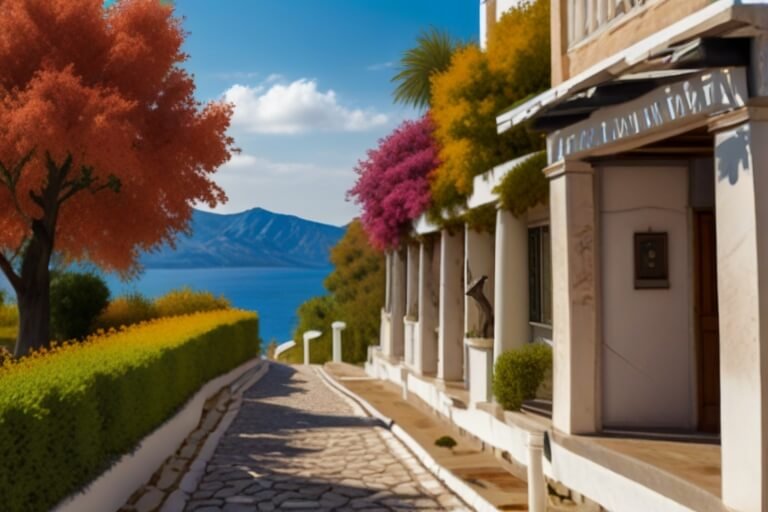
- Delightful Weather: Spring (April to May) and autumn (September to October) offer pleasant temperatures—ideal for sightseeing and outdoor activities. You’ll avoid the scorching heat of summer and the chilly winter winds.
- Lower Prices: Shoulder seasons bring more budget-friendly options. Accommodations and flights are often cheaper, and you’ll find better deals on tours.
- Fewer Crowds: Explore historical sites without jostling through crowds. Imagine wandering through the ancient ruins of Epidaurus or the Palace of Knossos in Crete with fewer fellow travelers.
- Perfect for Hiking: Spring and autumn are excellent for hiking. The Samaria Gorge in Crete, the trails of Meteora, and the Vikos Gorge in Zagori await intrepid adventurers.
Winter (December to February)
- Moody and Budget-Friendly: Greece wears a different cloak in winter. While some islands virtually hibernate, others reveal their quiet charm. Athens, Thessaloniki, and Crete are still vibrant. Plus, prices drop significantly.
- Off-the-Beaten-Path Adventures: Explore the ancient theaters of Epidaurus or the Byzantine city of Mystras without the crowds. Delve into local life, sip warm rakomelo, and discover cozy tavernas.
- Island Life: Some islands, like Rhodes and Crete, remain lively year-round. Enjoy the tranquility of empty beaches and the warmth of local hospitality.
Let’s delve into more details about prioritizing your wishlist and creating a plan for your Greek adventure:
2. Prioritize Your Wishlist and Make a Plan
Beach Bliss: Sun, Sand, and Salty Breezes
- Island Hopping: If your heart craves turquoise waters, sandy beaches, and lazy afternoons, prioritize island hopping. Start with the iconic Mykonos—known for its lively beach clubs and vibrant nightlife. Then sail to Paros, where golden beaches meet charming villages. Finally, unwind in Naxos, where ancient temples and serene beaches coexist.
- Santorini: No beach lover’s list is complete without Santorini. Explore the volcanic beaches—Red Beach, Kamari Beach, and Perissa Beach. Don’t miss the famous Oia sunset—a mesmerizing blend of colors over the caldera.
History and Culture: Unearth Ancient Treasures
- Athens: Begin your cultural journey in Athens. Visit the Acropolis, where the Parthenon stands as a testament to ancient Greek civilization. Explore the National Archaeological Museum, home to exquisite artifacts.
- Delphi: Seek wisdom at the Oracle of Delphi. Wander among ancient ruins and marvel at the Theater and Temple of Apollo.
- Crete: Dive into Minoan history at the Knossos Palace. Discover the mythical labyrinth and the story of King Minos.
Wildlife and Nature: Off the Beaten Path
- Zagori: Venture to the Vikos Gorge, one of the deepest canyons in the world. Hike through lush forests and encounter rare wildlife.
- Meteora: Marvel at monasteries perched atop towering rock formations. The spiritual energy here defies gravity.
- Samaria Gorge: Trek through this rugged gorge in Crete. Keep an eye out for wild goats and endemic plants.
Nightlife: Dance Till Dawn
- Mykonos: The party capital of Greece. Dance under the stars at Cavo Paradiso or sip cocktails at Scorpios.
- Thessaloniki: Greece’s second-largest city offers a vibrant nightlife scene. Explore the waterfront bars and clubs.
- Athens: The city that never sleeps. Head to Gazi for trendy bars and live music.
Let’s explore the Greek islands and regions in more detail:
Find the Perfect Island or Region for You
Mykonos and Santorini: Iconic and Bustling
- Mykonos:
- Beach Parties: Mykonos is synonymous with beach parties, vibrant nightlife, and carefree vibes. Dance till dawn at beach clubs like Cavo Paradiso.
- Windmills and Whitewashed Streets: Explore the charming alleys of Mykonos Town. Admire the iconic windmills overlooking the sea.
- Sunsets: Witness magical sunsets from Little Venice—a row of colorful houses perched on the water’s edge.
- Santorini:
- Caldera Views: Santorini’s caldera views are legendary. Stay in a cave hotel in Oia or Fira for front-row seats to the sunset.
- Volcanic Beaches: Visit the unique Red Beach, where red cliffs meet black sand. Kamari Beach and Perissa Beach are equally stunning.
- Ancient Akrotiri: Explore the ancient Minoan city of Akrotiri, preserved under volcanic ash.
- Amorgos:
- Secluded Beauty: Amorgos remains blissfully unspoiled. Discover secluded beaches like Agia Anna and Mouros.
- Chora: Wander through the charming capital, Chora, with its narrow streets and blue-domed churches.
- Monastery of Panagia Hozoviotissa: Perched on a cliff, this 11th-century monastery offers breathtaking views.
- Kythira:
- Off the Beaten Path: Kythira is a tranquil escape. Explore hidden coves, such as Kaladi and Fyri Ammos.
- Chora and Kapsali: Chora’s Venetian architecture and Kapsali’s waterfront tavernas are delightful.
- Cave of Agia Sophia: Discover this mystical cave with a natural pool.
Crete: Minoan History and Rugged Beauty
- Knossos Palace: Dive into Minoan history at the Knossos Palace. The legendary labyrinth awaits
- Samaria Gorge: Hike through Europe’s longest gorge. Walls of rock tower above as you follow the riverbed.
- Chania: Stroll through the charming old town of Chania. The Venetian harbor and colorful buildings are enchanting.
Let’s explore each of these points in more detail:
4. Athens Isn’t the Only Gateway to Greece
While Athens is undoubtedly a fantastic starting point for your Greek adventure, there are other gateways that offer unique experiences:
Thessaloniki: The Northern Gem
- International Airport: Thessaloniki boasts an international airport with connections to major European cities. It’s a convenient entry point if you’re arriving from elsewhere in Europe.
- Cultural Richness: Explore Thessaloniki’s vibrant cultural scene. Visit the White Tower, the Rotunda, and the Arch of Galerius. Don’t miss the bustling Modiano Market for local flavors.
Island Airports: Direct Flights to Paradise
- Mykonos: Fly directly to Mykonos for a quintessential Greek island experience. The island’s airport connects to major European cities. Mykonos offers dazzling beaches, luxury resorts, and a lively nightlife scene.
- Santorini: Santorini’s airport welcomes travelers from around the world. Arrive to witness the iconic caldera views, explore volcanic beaches, and immerse yourself in the island’s romantic ambiance.
- Corfu: Corfu’s airport provides direct flights. This lush green island in the Ionian Sea offers Venetian architecture, olive groves, and crystal-clear waters.
5. Book Everything in Advance During Peak Season
Greece’s peak season (June to August) is a magnet for travelers. To ensure a smooth trip:
- Accommodations: Reserve your hotels or villas well in advance. Popular destinations like Santorini and Mykonos fill up quickly.
- Ferry Tickets: If you plan to island-hop, book ferry tickets early. High-speed ferries between islands can get crowded.
- Tours and Activities: Pre-book popular tours, such as sunset cruises or archaeological site visits. You’ll avoid disappointment and long queues.
6. Roads in Greece Are for Confident Drivers
While Greece’s cities have well-maintained roads, venturing beyond urban areas requires some confidence:
- Island Exploration: If you’re exploring beyond the cities, be prepared for winding coastal roads, mountain passes, and steep cliffs. Renting a car allows flexibility.
- Driving Etiquette: Greeks drive assertively, especially in cities. Keep an eye out for scooters and pedestrians. Remember that traffic rules may differ from what you’re used to.
7. Greece Is Not Very Wheelchair-Friendly Beyond Athens
While Athens has made strides in accessibility, other regions may pose challenges:
- Islands: Many Greek islands have uneven terrain, cobblestone streets, and steps. Research wheelchair-friendly accommodations and attractions in advance.
- Historical Sites: Ancient ruins and archaeological sites may not be fully accessible. Some, like the Acropolis, have limited wheelchair access.
8. Pack the Right Kinds of Clothing
Greece’s climate varies, so pack accordingly:
- Summer: Lightweight clothing, swimsuits, and plenty of sunscreen. Sunglasses and a wide-brimmed hat are essential.
- Shoulder Seasons (Spring and Autumn): Layers are key. Mornings and evenings can be cool, while afternoons are warm.
- Winter: Warm layers, especially if you’re visiting the mainland. Rain gear is advisable.
Day 1: Athens—Where Gods and Mortals Converge
Morning: Ascending the Acropolis
As the sun begins its ascent over Athens, you find yourself standing at the base of the Acropolis—a timeless sentinel that has witnessed the rise and fall of empires. The marble columns of the Parthenon stretch toward the sky, their weathered surfaces etched with stories of gods and heroes. You take a deep breath, feeling the weight of history settle upon your shoulders.
The climb is not arduous, but each step carries you further back in time. As you ascend the ancient pathway, you pass remnants of temples dedicated to Athena and other deities. The air is thick with reverence, and you imagine the whispers of philosophers, poets, and statesmen who once walked these same steps.
And then, there it is—the Parthenon. Its grandeur defies description. The Doric columns stand tall, their proportions meticulously calculated to create an illusion of perfect symmetry. You run your fingers along the weathered stone, wondering about the hands that shaped it centuries ago. From this vantage point, Athens sprawls below—a city of gods and mortals, past and present.
Afternoon: Cobblestone Streets and Culinary Delights in Plaka
Descending from the Acropolis, you find yourself in Plaka—the heart of old Athens. Cobblestone streets wind through this historic neighborhood, revealing hidden courtyards, Byzantine churches, and colorful houses adorned with bougainvillea. The air is fragrant with the scent of grilled meats and freshly baked bread.
You choose a taverna tucked away in a quiet corner. The wooden tables spill onto the narrow street, inviting passersby to linger. The menu offers a tantalizing array of Greek delicacies. You opt for moussaka—a comforting layering of eggplant, minced meat, and béchamel sauce. The flavors dance on your tongue, evoking memories of family gatherings and sun-drenched afternoons.
Next comes souvlaki—grilled skewers of marinated meat, served with warm pita bread and tangy tzatziki. You savor each bite, the combination of herbs and spices transporting you to sun-kissed islands and seaside tavernas. Around you, locals chat animatedly, their laughter punctuating the lazy afternoon.
Evening: The Changing of the Guard at Syntagma Square
As the sun begins to dip below the horizon, you make your way to Syntagma Square—the beating heart of modern Athens. The neoclassical buildings stand in stark contrast to the ancient ruins you explored earlier. Here, the rhythms of democracy and governance play out.
A crowd gathers in front of the Hellenic Parliament. The guards—known as the Evzones—wear traditional uniforms: pleated kilts, red caps, and pom-pom-tipped shoes. Their synchronized movements are a choreographed ballet—a blend of tradition and precision. As the sun sets, they change shifts, their ceremonial steps echoing centuries of history.
You watch, transfixed, as the torches are lit, casting an otherworldly glow on the marble facade. The Evzones remain stoic, their duty unwavering. In this moment, you feel the pulse of Athens—the convergence of gods and mortals, ancient and modern.
As you walk back to your hotel, the city hums around you. Athens has welcomed you into its embrace, and you know that this is just the beginning of your Greek odyssey.
Day 2: Delphi—The Oracle’s Whisper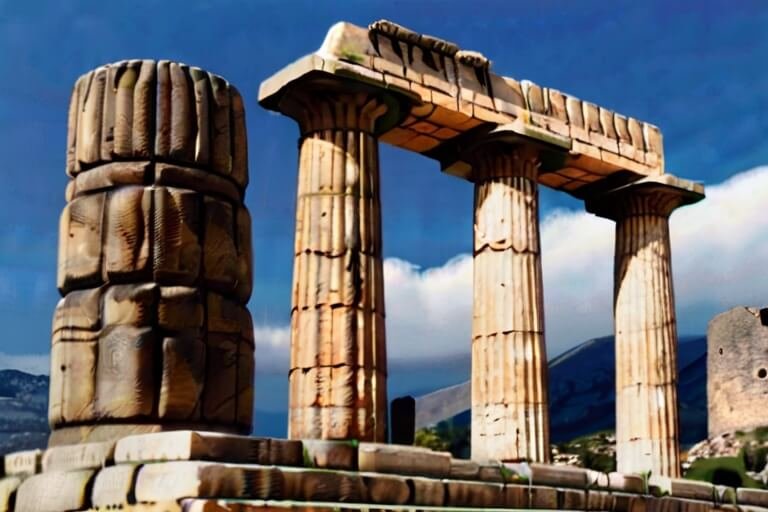
Morning: Ascending to the Navel of the World
As the sun casts its golden rays over the rugged landscape, you set out on a journey—a pilgrimage to Delphi, the ancient sanctuary perched on the slopes of Mount Parnassus. The road winds through olive groves, their silver leaves shimmering in the morning light. The air smells of earth and history.
Delphi was once considered the center of the world—the omphalos, where heaven and earth met. As you approach, the Temple of Apollo emerges—a majestic structure with Doric columns reaching toward the sky. You step into its sacred precinct, where pilgrims once sought answers from the Oracle.
The Oracle of Delphi—the priestess of Apollo—sat on a tripod, inhaling the vapors rising from a chasm in the earth. Her prophecies were cryptic, veiled in riddles. Kings and commoners alike sought her wisdom. You imagine their footsteps echoing through the temple, their hearts pounding with anticipation.
You explore the theater—a semicircular marvel carved into the mountainside. Here, ancient dramas unfolded—the tragedies of Aeschylus, the comedies of Aristophanes. The stone seats still bear the imprint of countless spectators.
And then, you stand before the omphalos—a stone marking the center of the world. You touch it, feeling the pulse of millennia. What questions would you ask if the Oracle were here? What mysteries lie hidden in the folds of time?
Afternoon: Whispering Springs and Ancient Echoes
Leaving the temple behind, you follow a path that leads deeper into the hills. Olive trees give way to cypress and pine. The Castalian Spring gurgles—a source of purity and inspiration. Pilgrims once bathed here, seeking purification before consulting the Oracle. You cup your hands, tasting the cool water. Does it still carry the whispers of ancient truths?
The path leads to the Tholos—a circular building with elegant columns. Some say it housed the Pythia, the Oracle herself. Others believe it was a monument to Apollo. You sit on a fallen stone, listening to the wind rustle the leaves. Perhaps the spirits of poets and philosophers still linger here.
Evening: Sunset Over Time’s Tapestry
As the sun begins its descent, you climb to the Delphi Archaeological Museum. Its halls are a treasure trove—an ode to Delphi’s past. Here, ancient artifacts come alive. You marvel at the bronze Charioteer of Delphi, frozen in eternal motion. His eyes seem to follow you, as if guarding the secrets of the Oracle.
And then, you step onto the terrace. The sun paints the sky in hues of crimson and gold. The mountains stretch before you, their contours softened by twilight. The Oracle’s whispers are carried on the breeze—the answers she gave, the questions left unanswered.
As the last rays disappear, you realize that Delphi is more than ruins and stones. It’s a portal—a threshold between mortal and divine, past and present. You leave, carrying the echoes of prophecy, the taste of spring water, and the weight of centuries.
Day 3: Santorini—Sunsets and Secrets
Morning: A Ferry Ride to Paradise
The morning sun casts a warm glow as you step aboard the ferry bound for Santorini. The Aegean Sea stretches before you—an expanse of cerulean blue, promising adventure and wonder. The breeze carries the scent of salt and anticipation.
As the island comes into view, you understand why Santorini is a dream etched in every traveler’s heart. The cliffs rise dramatically from the sea, their volcanic origins evident in the rugged rock formations. Fira—the island’s capital—perches on the edge of this ancient caldera. White-washed buildings cling to the cliffs like snowflakes, their blue-domed roofs mirroring the sky.
You disembark at the bustling port, greeted by the sound of laughter and clinking glasses. The narrow streets of Fira wind upward, beckoning you to explore. You pass boutique shops selling handmade jewelry, cafes with views that steal your breath, and tavernas where the aroma of grilled seafood dances in the air.
Afternoon: Oia—A Canvas of Beauty
A short drive takes you to Oia—a village that seems plucked from a fairytale. The streets narrow, the buildings huddle together, and bougainvillea spills over every balcony. Windmills stand sentinel, their sails catching the breeze. You wander through hidden alleys, discovering art galleries, boutiques, and charming cafes.
And then, there it is—the iconic view. You stand on the edge of the caldera, gazing across the sea. The domes of Oia’s churches punctuate the skyline, their blue hues echoing the water below. The wind whispers secrets—the stories of sailors, lovers, and dreamers who have stood here before you.
You find a quiet spot to sit—a perch with an unobstructed view. The sun begins its descent, painting the sky in shades of coral and gold. The caldera glows—a canvas of beauty. As the sun sinks below the horizon, applause erupts from the crowd. Strangers become friends, united by this shared spectacle.
Evening: Dining with the Gods
As darkness settles, you make your way to a cliffside taverna. Candlelight flickers, casting shadows on the whitewashed walls. The menu offers a symphony of flavors—saganaki with honey, octopus stifado, and baklava for dessert. You sip local wine, its taste as rich as the volcanic soil.
And then, you look out—the caldera stretches before you, a liquid mirror reflecting the moon. The lights of Fira twinkle, and the stars seem closer than ever. You raise your glass to Santorini—to its sunsets, its secrets, and the promise of tomorrow.
As you leave, you know that this island has woven itself into your soul. Santorini—the place where gods and mortals meet—is more than a destination. It’s a love affair, an eternal dance between earth and sky.
Day 4: Mykonos—Where Night Turns to Day
Morning: Sailing to Hedonistic Mykonos
The sun rises over the Aegean Sea, casting a golden path toward Mykonos—the island of hedonistic delights. You step aboard a ferry, the salt-kissed breeze carrying whispers of anticipation. As the boat glides across the azure waters, you catch your first glimpse of Mykonos—a vision of white and blue against the cerulean canvas.
The harbor welcomes you with open arms. Windmills stand sentinel, their wooden sails turning lazily in the morning light. These iconic structures once ground wheat, but now they serve as guardians of Mykonos’ soul. You imagine them whispering tales of sailors, pirates, and lovers who sought refuge on this enchanting island.
Afternoon: The Labyrinth Beckons
Mykonos Town—a maze of narrow alleys and whitewashed buildings—awaits your exploration. You lose yourself in the labyrinth, each turn revealing a new delight. Bougainvillea spills over stone walls, and cats nap in sun-drenched corners. The scent of freshly baked bread mingles with the tang of sea salt.
Boutiques beckon with handmade treasures—linen dresses, leather sandals, and delicate jewelry. You pause at a café, sipping strong Greek coffee as the world passes by. The locals chat animatedly, their laughter punctuating the lazy afternoon. You feel like an insider, a part of this sun-soaked tapestry.
Evening: Dancing with the Gods at Cavo Paradiso
As the sun begins its descent, you head to Cavo Paradiso—a legendary beach club perched on a cliff. The music pulses, the bass reverberating through your bones. The dance floor overlooks the sea, and the moon hangs low, casting a silvery glow. You join the crowd—locals, travelers, and free spirits—all moving to the rhythm of the night.
The DJ weaves a spell, blending ancient beats with modern melodies. You dance with strangers, your feet sinking into the sand. The moon watches, jealous of your revelry. The sea sparkles, mirroring the stars above. You lose track of time—here, night turns to day, and the boundaries blur.
As dawn approaches, you find a quiet spot. The horizon blushes with pink and gold, and you realize that Mykonos is more than a party island. It’s a place where time bends, where hedonism and spirituality coexist. You raise your arms, spinning with abandon, and the moon smiles down.
Conclusion: Mykonos’ Eternal Dance
Mykonos—the island of windmills, secrets, and endless nights. As you leave Cavo Paradiso, you carry its energy—the pulse of the sea, the beat of the music, the taste of salt on your lips. Mykonos dances with the gods, and you’re invited to join.
Day 5: Crete—Minoan Mysteries and Rugged Beauty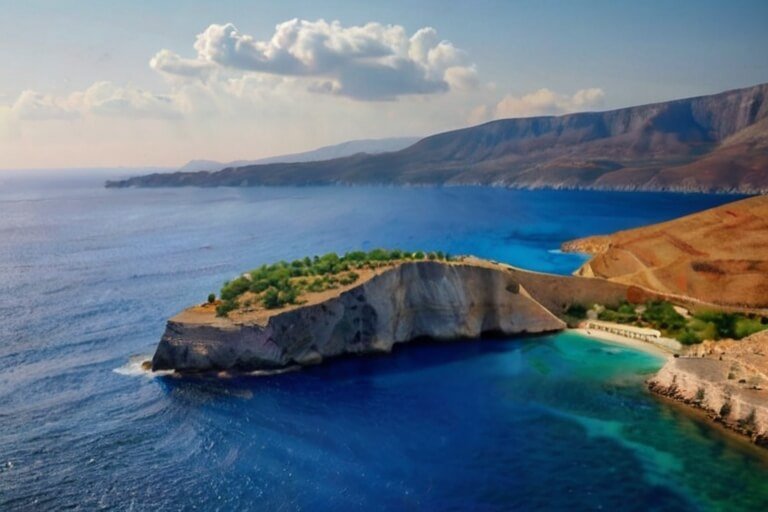
Morning: The Island of Legends Beckons
Crete—a land where myths intertwine with reality. You board a flight, leaving the azure waters of Santorini behind. Crete unfolds beneath you—a patchwork of olive groves, rugged mountains, and ancient ruins. As the plane descends, you catch glimpses of the Knossos Palace—a labyrinth of secrets waiting to be unraveled.
The Minoans—the first advanced civilization of Europe—once ruled Crete. Knossos was their heart—a palace complex where kings held court, priests communed with gods, and queens danced in frescoed halls. You step into this ancient world—the air thick with whispers. The Throne Room beckons, its alabaster throne waiting for a ruler lost to time. You imagine King Minos, the Minotaur, and the enigmatic Linear A script—the Minoan language that defies translation.
Afternoon: The Samaria Gorge—A Journey Through Time
Leaving Knossos behind, you head south. The Samaria Gorge awaits—a natural wonder carved by ancient rivers. Walls of rock rise, their layers revealing epochs. The path winds downward, and you follow—the sun dappling through pine trees. The air smells of wild herbs and pine resin.
As you descend, you sense the whispers—the voices of pilgrims, traders, and rebels who traversed this gorge. The Iron Gates narrow—the cliffs almost touching. You step over ancient stones, worn smooth by countless footsteps. The river murmurs, carrying secrets whispered by ancient winds.
And then, you emerge—the gorge widens, revealing a valley. The sea sparkles in the distance. You’ve walked through time—a journey from the mountains to the Libyan Sea. The Agia Roumeli beach awaits, its pebbles cool underfoot. You dip your toes—the same sea that once cradled ships of cedar and bronze.
Evening: Chania’s Harbor—A Venetian Tale
A ferry takes you to Chania—a harbor town where Venetian and Ottoman echoes blend. The Venetian Harbor welcomes you—a mosaic of pastel buildings, wooden balconies, and fishing boats. The scent of salt and grilled fish hangs in the air.
You dine at a waterfront taverna. The menu offers dolmades, lamb kleftiko, and raki—Crete’s fiery spirit. The sun sets, casting a golden glow on the harbor. The Bourtzi Fortress stands sentinel—a relic of Venetian rule. You sip raki, feeling its warmth—the taste of centuries.
As the stars emerge, you realize that Crete is more than an island. It’s a palimpsest—a layering of civilizations, myths, and memories. You raise your glass—to Knossos, to the Samaria Gorge, to Chania. The stars mirror in the Argolic Gulf, and you feel the pulse of ancient Crete—the heartbeat of legends.
Day 6: Nafplio—A Fairy Tale Unfolds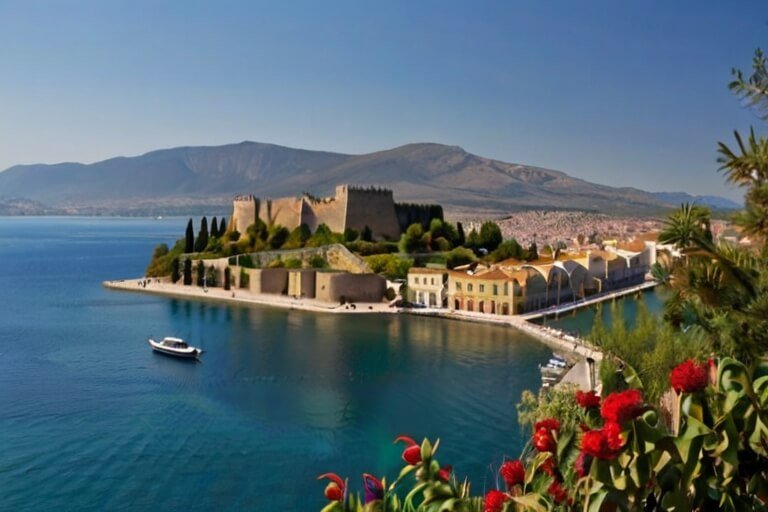
Morning: Cobblestone Streets and Palamidi Heights
You bid farewell to Crete, flying to the Peloponnese—a land of myths and olive groves. Nafplio awaits—a town straight from a fairy tale. Cobblestone streets wind through the old town, leading you to the Palamidi Fortress. You climb—each step revealing a new view. The fortress crowns the hill, its Venetian walls standing proud. From here, you see Nafplio—the harbor, the red-tiled roofs, and the Argolic Gulf stretching to infinity.
The fortress whispers of battles, prisoners, and forgotten heroes. You explore—the dungeons, the cannons, the hidden passages. The wind carries echoes—the footsteps of Venetian soldiers, Ottoman warriors, and Greek revolutionaries. You stand at the edge—the sea crashing against cliffs. The view is your reward—a panorama of land and sea, past and present.
Afternoon: Coffee by the Harbor—A Moment of Tranquility
Descending from Palamidi, you find a café by the harbor. The tables spill onto the promenade—the sea breeze ruffling your hair. You sip Greek coffee—the grounds settling like sediment. The harbor comes alive—fishing boats unloading their catch, children chasing seagulls, and old men playing backgammon.
You watch the waves—their rhythm soothing. The Bourtzi Fortress floats on the water—a tiny island with a turbulent history. You imagine Venetian nobles sipping wine, Ottoman pashas negotiating treaties, and pirates plotting raids. Nafplio’s harbor has seen it all—a theater of human drama.
Evening: Seafood Dinner at Taverna 1930
As the sun dips below the horizon, you head to Taverna 1930—a cozy restaurant overlooking the harbor. The scent of grilled octopus and garlic wafts from the kitchen. The tables are set with blue-and-white checkered cloths, and candles flicker in glass lanterns.
You start with taramasalata—a creamy blend of fish roe, olive oil, and lemon. The flavors transport you—the saltiness of the sea, the tang of citrus. Next comes psari plaki—a baked fish dish with tomatoes, onions, and herbs. The fish flakes apart, tender and flavorful.
The night deepens, and you sip raki—Crete’s fiery spirit. It warms your throat, igniting conversations with fellow diners. The stars mirror in the Argolic Gulf—the same stars that guided ancient mariners, traders, and explorers.
As you linger over dessert—a slice of honey-soaked baklava—you realize that Nafplio is more than a town. It’s a crossroads—a meeting point of cultures, histories, and flavors. You raise your glass—to Palamidi, to the harbor, to the moon dancing on the water. Nafplio’s magic wraps around you, and you know that this fairy tale will linger long after you’ve left.
Day 7: Athens Revisited—Farewell, for Now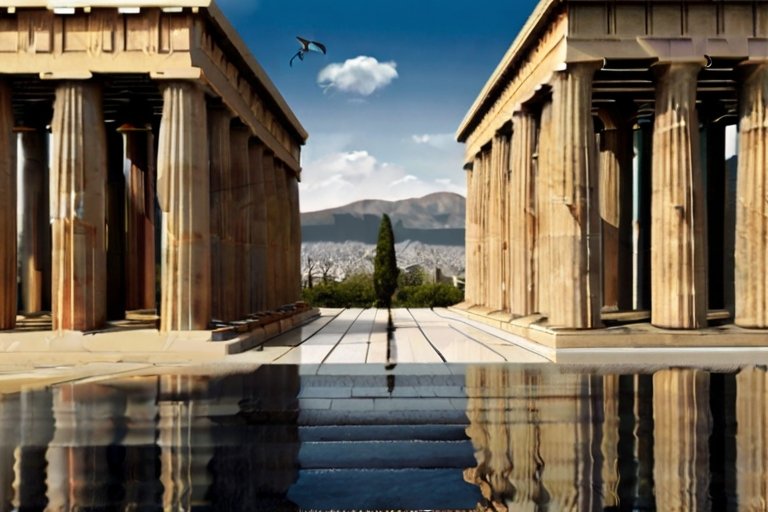
Morning: A Gaze Upon Ancient Statues
You return to Athens—a city that has embraced you like an old friend. The National Archaeological Museum awaits—a treasure trove of antiquities. As you step inside, the air thickens with history. Ancient statues watch over you—their marble eyes following your every move.
The Artemision Bronze stands tall—a once-lost masterpiece. Its sinewy form captures the essence of a god—a silent witness to the rise and fall of civilizations. You imagine it adorned with armor, its bronze gleaming in the sun. The Antikythera Mechanism lies nearby—an ancient computer that mapped the stars and planets. Its gears whisper secrets—the calculations of astronomers long gone.
Afternoon: Contemplation on Mount Lycabettus
You ascend Mount Lycabettus—a hill that cradles Athens. The path winds upward, shaded by pine trees. As you climb, the city sprawls below—a patchwork of rooftops, ancient ruins, and modern life. The Acropolis stands proud—a beacon of human achievement. You find a quiet spot—a stone bench overlooking the city. The breeze carries the scent of pine and history.
From here, Athens is a palimpsest. The Parthenon—the temple to Athena—gleams, its columns etched with stories. The Odeon of Herodes Atticus nestles within the Acropolis—a theater where ancient plays still echo. You close your eyes, listening—the voices of Sophocles, Euripides, and Aristophanes. The city murmurs—the laughter of children, the clatter of coffee cups, the hum of traffic. Athens is a symphony—a blend of gods and mortals, past and present.
Evening: A Toast to Greece’s Eternal Muse
You dine at Kuzina—a rooftop restaurant overlooking the Acropolis. The sun sets—the Parthenon bathed in golden light. You raise your glass—to Greece—an eternal muse. The wine is rich—its taste a blend of sun-soaked grapes and ancient soil. The Acropolis glows—the moon rising behind it. You feel small—a fleeting moment in the grand tapestry of time.
As you leave, you know that Athens will linger—the scent of olives, the sound of bouzouki music, the warmth of strangers’ smiles. Farewell, for now. Greece—the land of gods and poets—will call you back.
Estimated Costs for a Memorable Trip to Greece
Greece—a land of ancient myths, sun-kissed islands, and vibrant culture. Whether you’re exploring Athens’ historical treasures, island-hopping in the Cyclades, or hiking through rugged landscapes, budgeting wisely ensures you make the most of your Greek adventure. Let’s break down the estimated costs for transportation, accommodation, food, and activities.
1. Transportation
| Mode of Transport | Estimated Cost (USD) |
|---|---|
| Flights (Round Trip) | $600 – $1,200 |
| Domestic Flights (Island Hopping) | $50 – $150 per leg |
| Ferries (Between Islands) | $20 – $100 per leg |
| Local Buses and Trains | $2 – $10 per ride |
| Taxis | $10 – $30 per ride |
| Car Rentals (Per Day) | $30 – $80 |
Tips:
- Book flights and ferries in advance for better deals.
- Consider a Eurail pass if exploring mainland Greece.
2. Accommodation
| Type of Accommodation | Estimated Cost (USD) |
|---|---|
| Hostels (Dorm Beds) | $15 – $40 per night |
| Budget Hotels | $50 – $100 per night |
| Mid-Range Hotels | $100 – $200 per night |
| Luxury Resorts | $200+ per night |
Tips:
- Opt for guesthouses or family-run accommodations for an authentic experience.
- Consider Airbnb or vacation rentals for more space and local insights.
3. Food and Dining
| Meal Type | Estimated Cost (USD) |
|---|---|
| Street Food (Gyros, Souvlaki) | $3 – $5 |
| Casual Restaurants | $10 – $20 per meal |
| Mid-Range Restaurants | $20 – $40 per meal |
| Fine Dining | $50+ per meal |
Tips:
- Sample local dishes like moussaka, feta cheese, and baklava.
- Explore local markets for fresh produce and affordable meals.
4. Activities and Sightseeing
| Activity | Estimated Cost (USD) |
|---|---|
| Acropolis Entrance Fee | $20 |
| Island Tours and Cruises | $50 – $100 |
| Guided Historical Tours | $30 – $60 |
| Beach Activities (Snorkeling, Kayaking) | $20 – $50 |
| Hiking (Samaria Gorge, Meteora) | $10 – $30 |
Tips:
- Many archaeological sites offer discounted tickets for students and seniors.
- Seek out free walking tours for local insights.
Total Estimated Cost for 7 Days in Greece
| Category | Estimated Total (USD) |
|---|---|
| Transportation | $300 – $800 |
| Accommodation | $350 – $1,400 |
| Food and Dining | $200 – $400 |
| Activities and Sightseeing | $100 – $300 |
| Miscellaneous (Souvenirs, Tips) | $50 – $100 |
| Grand Total | $1,000 – $3,000 |
Tips:
- Budget according to your travel style—whether you’re a backpacker or a luxury traveler.
- Be flexible and open to local experiences—it’s the heart of Greek hospitality.
Statistics: Incoming Tourists to Greece (2017-2021)
Greece—a timeless destination where ancient history meets azure seas. Let’s delve into the statistics of incoming tourists over the last five years. These numbers reflect the allure of Greece—the sun-drenched islands, archaeological wonders, and warm hospitality.
1. Total Tourist Arrivals
| Year | Number of Tourist Arrivals (in thousands) |
|---|---|
| 2017 | 30,121 |
| 2018 | 33,014 |
| 2019 | 34,154 |
| 2020 | 7,762 |
| 2021 | 6,762 |
Insights:
- The years 2017 to 2019 witnessed steady growth in tourist arrivals.
- The COVID-19 pandemic significantly impacted tourism in 2020 and 2021.
2. Leading Inbound Travel Markets
| Country of Origin | Number of Arrivals (in thousands) |
|---|---|
| Germany | 4,000 |
| United Kingdom | 3,500 |
| France | 2,800 |
| Italy | 2,500 |
| United States | 1,800 |
Insights:
- European countries dominate the list of leading inbound travel markets.
- Germany and the United Kingdom consistently contribute the highest number of tourists.
3. Popular Destinations
| Island/Region | Highlights |
|---|---|
| Santorini | Caldera views, volcanic beaches, sunsets |
| Mykonos | Beach parties, vibrant nightlife, windmills |
| Crete | Knossos Palace, Samaria Gorge, Minoan history |
| Athens | Acropolis, historical sites, vibrant city life |
| Nafplio | Palamidi Fortress, Venetian charm, harbor views |
Insights:
- Santorini and Mykonos remain top choices for travelers seeking sunsets and beach parties.
- Crete offers a blend of history and rugged beauty.
- Athens and Nafplio provide cultural experiences and picturesque landscapes.
4. Impact on Economy and Employment
| Year | Total Contribution to GDP (in billion euros) | Employment (in thousands) |
|---|---|---|
| 2019 | 38 | 800 |
| 2020 | 35 | 600 |
| 2021 | 20 | 400 |
Insights:
- Tourism significantly contributes to Greece’s economy and job market.
- The pandemic led to a decline in both GDP contribution and employment.
Greece Travel Packing Checklist
Planning a trip to Greece? Whether you’re exploring ancient ruins in Athens, island-hopping in the Cyclades, or hiking through rugged landscapes, packing smartly ensures a smooth and enjoyable journey. Here’s a concise checklist to cover all your essentials:
1. Essential Documents
| Item | Details |
|---|---|
| Passport | Valid for at least six months from your travel dates |
| Visa (if required) | Check Greece’s visa requirements for your nationality |
| Travel Insurance | Covers medical emergencies, trip cancellations, and lost belongings |
| Flight Tickets | Print or save electronic copies |
| Hotel Reservations | Confirmations for accommodation |
| Emergency Contacts | Write down local emergency numbers |
2. Clothing (All Seasons)
| Item | Details |
|---|---|
| Lightweight Tops | Breathable fabrics for warm weather |
| T-Shirts | Casual and versatile |
| Shorts | Comfortable for daytime |
| Dresses/Skirts | Lightweight and easy to dress up |
| Swimsuits | For beach days |
| Sun Hat | Protects from the sun |
| Sunglasses | Polarized lenses are ideal |
| Comfortable Shoes | Sandals, sneakers, and hiking shoes |
| Light Jacket/Cardigan | For cooler evenings |
| Scarf/Shawl | Versatile for layering |
3. Toiletries and Personal Care
| Item | Details |
|---|---|
| Sunscreen | High SPF for sun protection |
| Insect Repellent | Especially for island visits |
| Toiletry Bag | Toothbrush, toothpaste, shampoo, etc. |
| Medications | Any prescriptions or over-the-counter drugs |
| First Aid Kit | Bandages, antiseptic, pain relievers |
| Wet Wipes | Handy for freshening up |
| Travel Towel | Quick-drying and compact |
4. Electronics and Miscellaneous
| Item | Details |
|---|---|
| Universal Adapter | Greece uses Type C and F sockets |
| Power Bank | Keep devices charged on the go |
| Camera | Capture stunning landscapes |
| Portable Wi-Fi Device | Stay connected |
| Travel Pillow | Comfortable for long flights |
| Daypack/Backpack | For day trips and hikes |
5. Other Necessary Items
| Item | Details |
|---|---|
| Cash (Euros) | ATMs are widely available, but have some cash on hand |
| Reusable Water Bottle | Stay hydrated |
| Travel Locks | Secure your luggage |
| Travel Pillow | Comfortable for long flights |
| Snacks | For energy during excursions |
| Greek Phrasebook | Basic phrases for communication |
6. What Not to Bring
| Item | Reason |
|---|---|
| Valuables | Minimize the risk of loss or theft |
| Heavy Backpacks | Greece involves walking and stairs |
| Formal Attire | Casual dress code is common |
| Too Many Shoes | Stick to versatile pairs |
Frequently Asked Questions: How many days in Greece is enough?Here are answers to common questions travelers might have about visiting Greece. Whether you’re planning a short trip or an extended stay, these FAQs will help you make the most of your Greek adventure:
| Question | Answer |
|---|---|
| 1. Is Greece/Athens Safe to Travel? | Yes, Greece is generally safe for tourists. Exercise normal precautions and be aware of pickpocketing in crowded areas. |
| 2. Which are the Best Areas to Stay in Central Athens? | Plaka, Monastiraki, and Syntagma Square are great central locations. |
| 3. Do I need a Visa? What is ETIAS? | Most nationalities do not need a visa for short stays. ETIAS (European Travel Information and Authorization System) will be required starting in 2023. |
| 4. When is the Best Time to Go to Greece? | Spring (April to June) and fall (September to October) offer pleasant weather and fewer crowds. |
| 5. Is there an Uber in Greece? | No, but taxis are widely available. |
| 6. Which are the Top Must-See Sites all over Greece? | Acropolis, Meteora, Delphi, and Santorini are iconic. |
| 7. What are the Must-See Sites in Athens? | Acropolis, Ancient Agora, and the National Archaeological Museum are essential. |
| 8. Do I Need a Car in Athens? | Not necessary within Athens, but useful for day trips to nearby sites. |
| 9. Where to Store My Luggage in Athens? | Luggage storage facilities are available at airports, train stations, and some hotels. |
| 10. Are Credit Cards Widely Accepted? | Yes, credit cards are widely accepted, but carry some cash for smaller purchases. |
| 11. Should I Exchange Money in Greece? | ATMs are common, so withdrawing euros is convenient. |
| 12. Can I Drink the Tap Water? | Yes, tap water is safe to drink in most places. |
| 13. Is There a Dress Code in Greece? | Dress modestly when visiting monasteries or churches. Otherwise, casual attire is fine. |
| 14. Is it Safe for Women to Travel Solo in Greece? | Yes, Greece is generally safe for solo female travelers. |
| 15. Where to Go in Greece for the First Time? | Athens, Santorini, and Mykonos are popular choices. |
| 16. Which Behavior is Not Taken Well in Greece? | Avoid raising your voice or arguing in public. |
| 17. What is the Tipping Culture in Greece? | Tipping is appreciated but not mandatory. Round up the bill or leave 5-10%. |
| 18. What Difficulties you may Encounter in the Greek Islands? | Limited medical facilities on some islands. |
| 19. How to get to Piraeus Port from Athens Airport? | Take a taxi or use public transportation. |
| 20. Where Best to Stay in Athens? | Choose a neighborhood based on your preferences—historic, lively, or modern. |
| 21. Can I Visit the Greek Islands in Winter? | Some islands are accessible, but many services are limited. |
| 22. What is the Best Way to Explore the Greek Islands? | Island-hopping by ferry or domestic flights. |
| 23. How to Respect Local Customs and Traditions? | Dress modestly, avoid loud behavior, and greet people with a smile. |
| 24. What Currency is Used in Greece? | Euro (€) is the official currency. |
| 25. What Souvenirs Should I Buy in Greece? | Olive oil, local wines, ceramics, and handmade jewelry are great choices. |
Conclusion: Greece—Where Timeless Beauty Beckons
As the sun dips below the horizon, casting a golden glow on ancient stones, you realize that Greece is more than a destination—it’s an odyssey. From the marble columns of the Acropolis to the sun-kissed beaches of Santorini, this land whispers tales of gods and mortals, poets and philosophers. So, how many days in Greece are enough? The answer lies not in numbers but in moments—the ones that steal your breath, ignite your senses, and etch themselves into your soul.
Embrace the Magic
Greece is a symphony—a blend of turquoise seas, olive groves, and bougainvillea-clad villages. It’s the taste of feta cheese, the sound of waves lapping against ancient harbors, and the warmth of a stranger’s smile. It’s the Parthenon at sunrise, the windmills of Mykonos, and the scent of oregano in the air. It’s where gods and mortals converge, where time bends, and where every stone tells a story.
A Call to Action
So, dear traveler, heed the call. Book that flight, pack your bags, and let Greece weave its magic around you. Share this article with fellow wanderers, leave a comment about your own Greek adventures, and subscribe to our newsletter for more travel inspiration. Greece awaits—the land of sunsets, secrets, and eternal muses.
As you sip wine by the Venetian harbor, raise your glass—to Greece, to life, and to the promise of tomorrow. 🇬🇷✨
READ MORE:

